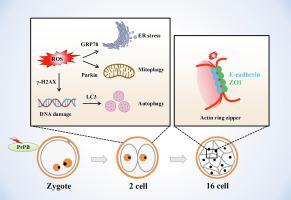对羟基苯甲酸丙酯通过引起氧化应激诱导的细胞器功能障碍和肌动蛋白拉链异常来破坏早期胚胎发育。
IF 3.4
3区 医学
Q2 PHARMACOLOGY & PHARMACY
引用次数: 0
摘要
对羟基苯甲酸丙酯(PrPB)是个人护理产品和食品中常用的防腐剂,但研究表明,它会破坏各种生理过程,尤其是生殖系统。我们之前的研究揭示了PrPB对小鼠卵母细胞成熟的毒性作用。然而,关于PrPB在早期胚胎中的毒性的知识仍然有限。在本研究中,我们证明了体外暴露于600 μM PrPB会增加ROS水平,诱导自噬、有丝自噬和内质网应激,最终导致4细胞期胚胎停滞。PrPB暴露通过诱导DNA损伤促进自噬,表现为溶酶体、LC3和γ - h2a的增强。X荧光信号。PrPB暴露增强了线粒体自噬,这表明线粒体与LAMP1和Parkin的共定位增加。PrPB暴露也引起内质网应激,内质网分布紊乱和Ca2+稳态异常。此外,600 μM PrPB暴露通过干扰ZO1和E-cadherin的定位,破坏了肌动蛋白拉链的形成,进一步影响囊胚的形成。虽然300 μM PrPB暴露不影响胚胎发育速率,但TE细胞数量减少,表明囊胚质量较差。综上所述,我们的研究结果表明,高剂量PrPB暴露会导致氧化应激诱导的细胞器功能障碍和肌动蛋白拉链形成异常,而低剂量PrPB暴露会影响早期谱系规范。本文章由计算机程序翻译,如有差异,请以英文原文为准。

Propylparaben disrupts early embryonic development by causing oxidative stress-induced organelle dysfunction and actin zipper abnormality
Propylparaben (PrPB) is a commonly used preservative in personal care products and food items, but studies have shown that it can disrupt various physiological processes, especially in the reproductive system. Our previous research revealed the toxic effects of PrPB on mouse oocyte maturation. However, knowledge about the toxicity of PrPB in early embryos remains limited. In the present study, we demonstrated that in vitro exposure to 600 μM PrPB increased ROS levels, inducing autophagy, mitophagy and ER stress, ultimately leading to embryonic arrest at the 4-cell stage. PrPB exposure promoted autophagy through the induction of DNA damage, reflected by enhanced lysosome, LC3 and γH2A.X fluorescence signals. PrPB exposure enhanced mitophagy, as indicated by increased colocalization of mitochondria with LAMP1 and Parkin. PrPB exposure also caused ER stress, as indicated by disordered ER distribution and abnormal Ca2+ homeostasis. In addition, 600 μM PrPB exposure disrupted the formation of the actin zipper by interfering with the localization of ZO1 and E-cadherin, further affecting blastocyst formation. Although 300 μM PrPB exposure did not affect the embryo development rate, a decreased of the percentage of TE/total cell number and a increased of the percentage of ICM/total cell number was observed, indicating poor blastocyst quality. Taken together, the results of our study demonstrate that high-dose PrPB exposure causes oxidative stress-induced organelle dysfunction and abnormal actin zipper formation, whereas low-dose PrPB exposure affects early lineage specification.
求助全文
通过发布文献求助,成功后即可免费获取论文全文。
去求助
来源期刊
CiteScore
6.80
自引率
2.60%
发文量
309
审稿时长
32 days
期刊介绍:
Toxicology and Applied Pharmacology publishes original scientific research of relevance to animals or humans pertaining to the action of chemicals, drugs, or chemically-defined natural products.
Regular articles address mechanistic approaches to physiological, pharmacologic, biochemical, cellular, or molecular understanding of toxicologic/pathologic lesions and to methods used to describe these responses. Safety Science articles address outstanding state-of-the-art preclinical and human translational characterization of drug and chemical safety employing cutting-edge science. Highly significant Regulatory Safety Science articles will also be considered in this category. Papers concerned with alternatives to the use of experimental animals are encouraged.
Short articles report on high impact studies of broad interest to readers of TAAP that would benefit from rapid publication. These articles should contain no more than a combined total of four figures and tables. Authors should include in their cover letter the justification for consideration of their manuscript as a short article.

 求助内容:
求助内容: 应助结果提醒方式:
应助结果提醒方式:


